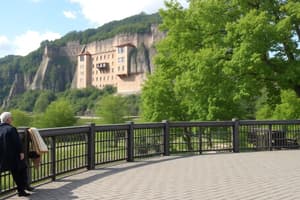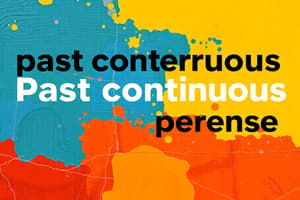Podcast
Questions and Answers
Which sentence correctly uses the past perfect continuous to describe an action leading up to a past event?
Which sentence correctly uses the past perfect continuous to describe an action leading up to a past event?
- He was tired because he ran five miles.
- I went to the store after I made lunch.
- She ate dinner after she finished her work.
- They felt prepared because they had been studying all week. (correct)
The past perfect continuous is formed using 'subject + had + past participle of the main verb'.
The past perfect continuous is formed using 'subject + had + past participle of the main verb'.
False (B)
We use the past perfect continuous to give ______ information about a situation or event.
We use the past perfect continuous to give ______ information about a situation or event.
background
Which of the following sentences uses the short form of 'had not' correctly?
Which of the following sentences uses the short form of 'had not' correctly?
Give an example of when you can use either the past perfect simple or the past perfect continuous.
Give an example of when you can use either the past perfect simple or the past perfect continuous.
When should you use the past perfect simple instead of the past perfect continuous?
When should you use the past perfect simple instead of the past perfect continuous?
Using the past perfect continuous focuses on the end result of an action rather than the process.
Using the past perfect continuous focuses on the end result of an action rather than the process.
If the earlier action is ______, use the past perfect continuous.
If the earlier action is ______, use the past perfect continuous.
Match the sentence with the correct tense usage:
Match the sentence with the correct tense usage:
Choose the sentence that correctly demonstrates the use of the past perfect continuous tense:
Choose the sentence that correctly demonstrates the use of the past perfect continuous tense:
Which tense is most appropriate for describing an action that occurred over a period of time before another past event?
Which tense is most appropriate for describing an action that occurred over a period of time before another past event?
The past perfect continuous is generally used to describe completed actions with no relevance to a later time.
The past perfect continuous is generally used to describe completed actions with no relevance to a later time.
Construct a sentence using the past perfect continuous to describe an activity you had been doing before starting to read this content.
Construct a sentence using the past perfect continuous to describe an activity you had been doing before starting to read this content.
They __________ (wait) for the bus for an hour when it finally arrived.
They __________ (wait) for the bus for an hour when it finally arrived.
Match the sentence halves to correctly illustrate the use of the past perfect continuous:
Match the sentence halves to correctly illustrate the use of the past perfect continuous:
In the sentence, 'After he had been practicing the piano, he felt ready for the concert,' what does the past perfect continuous indicate?
In the sentence, 'After he had been practicing the piano, he felt ready for the concert,' what does the past perfect continuous indicate?
The past perfect continuous is interchangeable with the past perfect simple in all contexts without affecting the meaning.
The past perfect continuous is interchangeable with the past perfect simple in all contexts without affecting the meaning.
Provide an example of a time conjunction commonly used with the past perfect continuous.
Provide an example of a time conjunction commonly used with the past perfect continuous.
Before the storm arrived, the wind __________ (blow) fiercely for several hours.
Before the storm arrived, the wind __________ (blow) fiercely for several hours.
In the sentence, 'She finally understood the math problem which she _____ trying to solve all day,' which verb form correctly completes the sentence?
In the sentence, 'She finally understood the math problem which she _____ trying to solve all day,' which verb form correctly completes the sentence?
Flashcards
Past Perfect Continuous: Structure
Past Perfect Continuous: Structure
Subject + had been + present participle (verb-ing).
Past Perfect Continuous: Use
Past Perfect Continuous: Use
Background information about a situation up to another past event, (usually in past simple).
Past Perfect Continuous: Negative Form
Past Perfect Continuous: Negative Form
Subject + hadn't been + present participle.
Completed Earlier Action
Completed Earlier Action
Signup and view all the flashcards
Incomplete Earlier Action
Incomplete Earlier Action
Signup and view all the flashcards
Past Perfect Simple
Past Perfect Simple
Signup and view all the flashcards
Past Perfect Continuous: Short Forms
Past Perfect Continuous: Short Forms
Signup and view all the flashcards
Past Perfect Continuous Focus
Past Perfect Continuous Focus
Signup and view all the flashcards
Earlier Action (Continuous)
Earlier Action (Continuous)
Signup and view all the flashcards
Past Perfect Simple vs. Continuous
Past Perfect Simple vs. Continuous
Signup and view all the flashcards
Past Perfect Continuous
Past Perfect Continuous
Signup and view all the flashcards
Function of Past Perfect Continuous
Function of Past Perfect Continuous
Signup and view all the flashcards
Emphasis on Duration
Emphasis on Duration
Signup and view all the flashcards
Past Simple for Later Action
Past Simple for Later Action
Signup and view all the flashcards
Sentence Order Flexibility
Sentence Order Flexibility
Signup and view all the flashcards
Use in Relative Clauses
Use in Relative Clauses
Signup and view all the flashcards
Time Conjunctions and PPC
Time Conjunctions and PPC
Signup and view all the flashcards
Timing of Action
Timing of Action
Signup and view all the flashcards
Emphasis
Emphasis
Signup and view all the flashcards
Study Notes
- The past perfect continuous is used to discuss past events that occurred before other past events.
- It provides background information to an event in the past.
Usage
- Used to describe something happening before another event or situation in the past.
- It states how long this earlier action was happening.
- The later action is expressed in the past simple tense.
- The earlier action can sometimes appear second in the sentence.
- Commonly used in relative clauses.
- Also used after time conjunctions.
Structure
- Formed with: subject + had been + present participle of the main verb.
- Negative form: subject + hadn't been + present participle.
- Short forms: I had = I'd; We had = we'd; had not = hadn't.
Alternatives
- Past perfect simple or past perfect continuous can be used for activities that continue for a long time (work, run, sleep).
- Use past perfect simple if the earlier action was completed.
- Use past perfect continuous if the earlier action is incomplete to focus on the process or length of time the action continued.
Studying That Suits You
Use AI to generate personalized quizzes and flashcards to suit your learning preferences.



